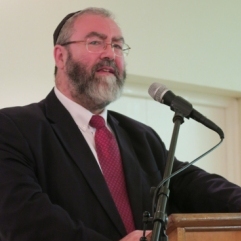
Community

Olesker speaks in Cape Town:Jews have an excellent story to tell the world
TALI FEINBERG
A Brit by birth now living in Jerusalem with his family, Olesker heads up the Jerusalem Centre for Communication and Advocacy Training (JCCAT). Addressing a large audience, Olesker demonstrated just how many stories there are to tell, and that these are particularly important to share in South Africa.
He has visited this country often, and described being on Radio 702 just after the 1994 transition to democracy. Amidst vitriolic statements from listeners, one caller asked if “what Israel is doing to the Palestinians is the same as how black people were treated under apartheid”.
Olesker said that he could not answer the question, because he would need time to elaborate on the complexities, but he did tell the caller that it was callous to exploit the memory of those persecuted under apartheid to score a cheap political point and that we shouldn’t call something “apartheid” just because it is something we don’t like.
Olesker named a number of practical ways of advocating for Israel:
Connect to emotions: By making the powerful and true statement while on Radio 702, Olesker managed to tap into the emotions of listeners who knew what it had been like to experience apartheid and may not have wanted this to be “transplanted” to other conflicts. Olesker explained how the black producer in the studio liked his response because he could relate to it. Therefore, it is key to connect to the emotions of others when advocating for Israel.
Learn to speak the language of the world: “Advocacy does not come naturally to Jews,” said Olesker, who elaborated that Jewish law asked questions, and it was not just about “who wins”. However, the world works according to advocacy, “and we have to adapt to this system to get our voices heard. It is up to us to empower ourselves with advocacy skills.”
Pictures are powerful: Olesker commented that the way the Western world communicates today is through visual images. “If a picture speaks a 1 000 words, Jews would choose the 1 000 words,” he quipped. Yet with the rise of Instagram and YouTube, we see that content is king and that images pack a punch.
He advised sharing photos from trips to Israel. “What could be more powerful than sharing a photo of a kid-friendly bomb shelter in Sderot, painted to look like a caterpillar?” he asked, or posting videos on social media, particularly sharing how anti-Semitic ideas are perpetuated on television in the Arab world. Cartoons are another way to make an impact.
Change the conceptual frame: In the example of speaking on radio, Olesker turned the situation around, creating a new conceptual frame where the caller became the exploiter of apartheid.
“Obtaining and maintaining control of the conceptual frame is key to advocacy,” said Olesker. He suggests that Jewish students put together an educational campaign to speak out against the human rights abuses in Darfur, which allows them to connect with other South Africans on this key issue.
Take the initiative: Although it may be challenging to raise discussion about Israel, this allows you to ask the questions and for someone else to give the answers. For example, in the hosting of a demonstration for Darfur, Olesker suggests inviting Muslim societies on campus. He hopes that they would join, but if they refuse, it would highlight that they do not support campaigning against Muslim-on-Muslim violence in Africa – totally changing the conceptual frame.
Tell your story: “Every Israeli has a story like mine,” says Olesker, who told how two worshippers killed in the Har Nof terrorist attack last year were close friends of his, and how his daughter had been just outside the synagogue when the attack occurred, as the shul was at the end of his street. “Just tell the truth, share people’s names, and your story will resonate. The journey of the Jewish people is the greatest story ever told.”




